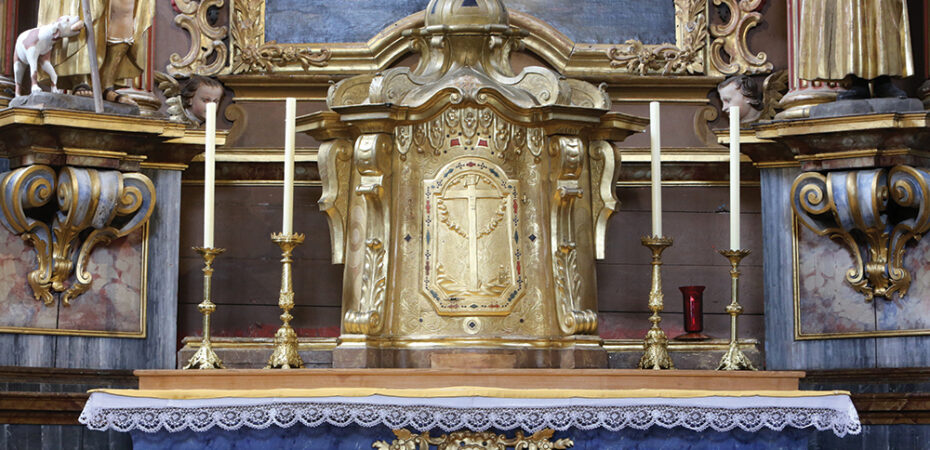Our Holy Sanctuary
Pondering the most sacred space of our churches with wonder and awe
D.D. Emmons Comments Off on Our Holy Sanctuary
In the Israelite tabernacle, and later in the Temple, there was a sacred space called the Holy of Holies, the place where the Ark of the Covenant was kept. No one, except the high priest, could enter inside, and that only once a year. The holiness and sanctity of the Temple are mirrored in the sanctuary of a Catholic church — here too is the Holy of Holies. As U.S. Catholics continue this period of reviving our love for the Eucharist, perhaps it is also a time for pondering anew an appreciation for the sacred area, the sanctuary of our churches that contains the most Blessed Sacrament. Indeed, our church is holy ground, similar to the ground where God told Moses (cf. Ex 3:5) and the angel told Joshua (cf. Jos 5:15) to remove their shoes.
The principal furnishings in a church sanctuary are identified in the document “Built on Living Stones” (USCCB, 2000), explaining: “The principal ritual furnishings within the sanctuary are the altar on which the eucharistic sacrifice is offered, the ambo from which God’s word is proclaimed, and the chair of the priest celebrant” (No. 55). Before focusing on those “ritual furnishings,” as well as the tabernacle, the baptismal font, the Easter candle and the Book of the Gospels, we first take a look at our worship space.
…………………………………………………………………………………………………………………………………………
Holy of Holies — Old Testament
In the Book of Exodus, God told Moses he wanted the Israelites to build a place [tabernacle] where he could “dwell in their midst” (25:8). He told them to divide the inside of the tabernacle with a veil: “Hang the veil from clasps. The ark of the covenant you shall bring inside, behind this veil which divides the holy place from the holy of holies” (26:33). The First Book of Kings describes the Temple and the holy of holies built by Solomon 480 years after the Israelites escaped from Egypt: “The priests brought the ark of the covenant of the LORD to its place, the inner sanctuary of the house [Temple], the holy of holies” (8:6). Like the Jewish tabernacle and Temple, a Catholic church is a holy place with a special area akin to the holy of holies.
………………………………………………………………………………………………………………………………………….
The space inside our church where we come together to worship God includes the nave and the sanctuary. The nave, from the Latin navis, meaning “navy” or “ship,” is made up of the pews surrounded by stained glass, crucifixes, stations of the cross and other beautiful sacramentals. The nave is distinct from the sanctuary, which is normally a raised area in front of the church where the Blessed Sacrament is located and where the holy sacrifice of the Mass is celebrated. The sanctuary is not a stage and, with rare exceptions, other activities do not take place there. The atmosphere is one of loftiness, exaltation or prominence; as such, only those who are ordained or selected with purposeful need should ascend into the sacred surroundings of the sanctuary. The demeanor of those celebrating and serving the Mass is one of prayerful reverence and focus on being in the presence of God; it is a place of wonderment and awe, where a miracle occurs at every Mass.
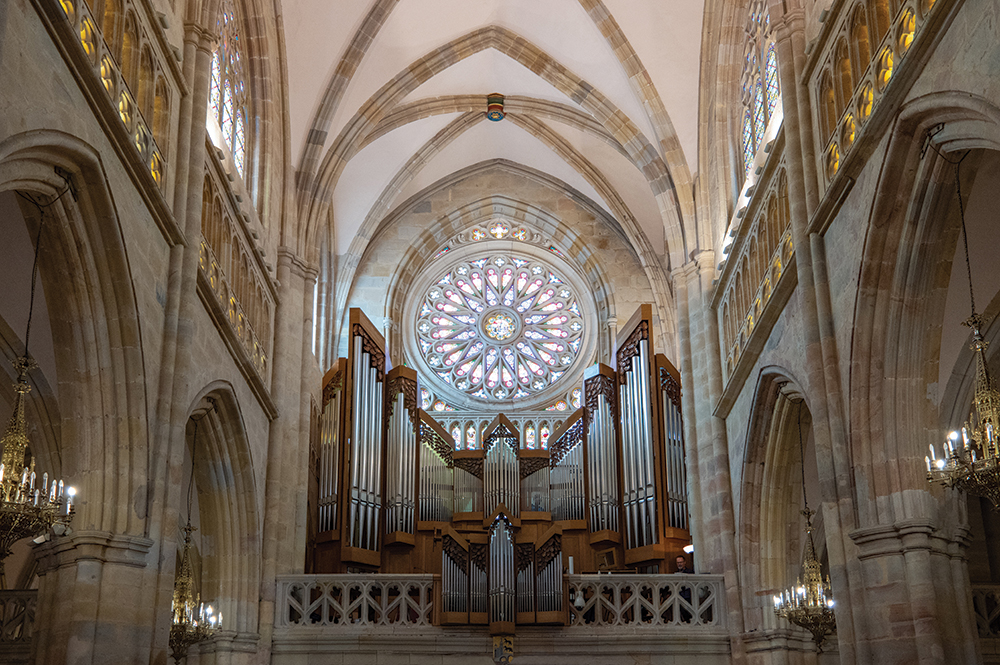
Coming into the Church
Crossing from the secular world into the nave, our eyes immediately search for the ever-burning red lamp that signifies the Real Presence, residing in the tabernacle. He is here, alive just as he was at Nazareth, around Lake Gennesaret, at Bethany, in Jerusalem. “In fact,” wrote Pope Benedict XVI (r. 2005-13), “the tabernacle is the complete fulfillment of what the Ark of the Covenant represented. It is the place of the ‘Holy of Holies.’ It is the tent of God, his throne. Here he is among us. His presence (Shekinah) really does now dwell among us — in the humblest parish church no less than in the grandest cathedral” (“The Spirit of the Liturgy,” Ignatius Press, $19.95).
Entering the nave, we genuflect, demonstrating our lowliness and our love for the Lord in the tabernacle; we will make that same gesture of homage when we depart. The priest celebrant reverently makes additional genuflections during the liturgy. Once the Mass begins, all in attendance give attention to the altar, regally placed in the sanctuary around which the liturgy unfolds. “The altar is the ‘center of thanksgiving that the Eucharist accomplishes’ and the point around which the other rites are in some manner arrayed” (“Built on Living Stones,” No. 56). The faithful bow each time passing in front of or approaching the altar.
The Center Piece
Every Catholic church is built for the altar — it is at the altar that the passion of Christ is commemorated, his sacrifice for our sins re-presented; here, too, is where the consecration of the bread and wine takes place and where we receive the body and blood of Christ in holy Communion. The altar is the center and focal point of every Mass and represents the presence of God.
“The Christian altar is the symbol of Christ himself, present in the midst of the assembly of his faithful” (No. 1383), according to the Catechism of the Catholic Church. The Catechism calls the altar the “center of the church.” (No. 1182); the importance and holiness of the altar is manifested when it is dedicated and consecrated.
The importance of the altar as a primary symbol of Christ should not be overlooked by the faithful. As Bishop Emeritus Ronald Gainer of the Diocese of Harrisburg said during the consecration of an altar on Oct. 6, 2023: “The altar is recognized as the primary symbol of Christ in the Church. That’s not to say we don’t have the real presence of Christ in the Eucharist reserved in the tabernacle and celebrated on the altar, but the altar as a symbol is the primary symbol because it has been Christened.”
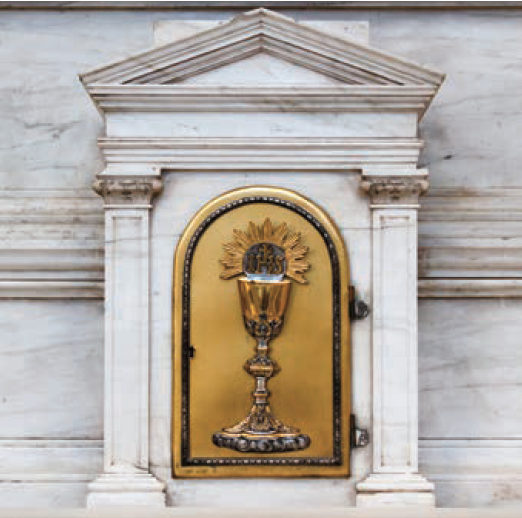
Sometimes, parishes have an aging, well-used altar. The tendency may be to use decorations to distract from focusing on this type of center piece of the sanctuary. Thus the altar can blend into the background of an overwhelming number of decorations, which sometimes include seasonal decorations of the secular world and holidays. Perhaps the use of beautiful frontals is a solution. No matter the situation, the holy sacrifice of the Mass still takes place on the altar.
Any concerns about an aging altar are to a degree put in perspective by Father Walter Ciszek, who writes about attempting to covertly say Mass in a Russian work camp and how the stump of a tree was used as an altar. He wrote that he and another priest would walk “into the forest and there offer Mass on the stump of a tree. I could not think how the forest somehow resembled a cathedral — the tall rows of towering trees arching over us” (“He Leadeth Me,” Image, $15.99).
There have been times in Church history when the altar was physically separated from the nave, such as with an altar rail or rood screens. A rood screen, popular in the Middle Ages, is a kind of latticework, made of wood, iron or metal and sometimes stretched across the sanctuary, and certainly in front of the altar. The screens were ornate and typically included a large crucifix, or rood, designed into part of the screen. Often, the bottom of the screen was solid, but the upper part was constructed so the laity could see some of the movements around the altar. Clearly, rood screens were used to separate the laity from the clergy.
Book of Gospels
“As the central object in the Liturgy of the Word, the Book of the Gospels ranks first among the sacred objects which come after the chalice and paten. … Because this book is a visible sign of Jesus Christ the Word of God, it should be handsomely bound or kept within richly worked covers, which may be made of precious metal (even jeweled and enameled), rich fabric or artistic embroidery. A set of different covers for different seasons or occasions may be appropriate” (“Ceremonies of the Modern Roman Rite,” Bishop Peter J Elliott, Ignatius Press, $29.95).
The Book of the Gospels is among the few items that can be placed on the altar. This book is carried by the deacon during the opening procession of the Mass and reverently laid in the center of the altar. When the Liturgy of the Word begins, the deacon carries the book to the ambo; there is great ceremony and symbolism in this act. The deacon is blessed by the Mass celebrant, he then picks up the book and, accompanied by two candle bearers, processes to the ambo while the congregation stands and sings the alleluia. Some theologians have compared this procession to the apostles taking the word of God to the gentiles. St. Augustine writes: “The Gospel is the mouth of Christ. He is seated in heaven, but he has not stopped speaking on earth.”
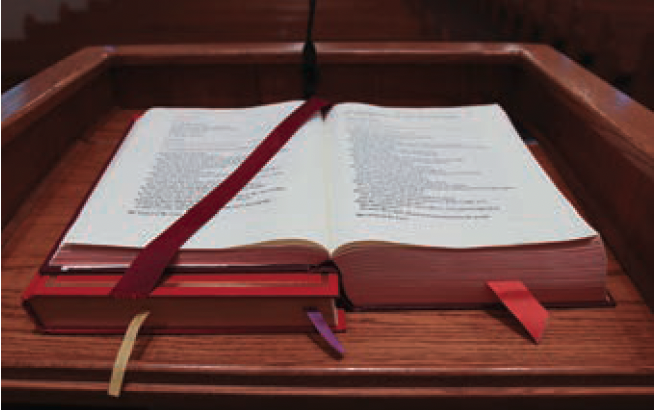
On certain occasions, the deacon will incense the book before reading the Gospel and always begins with the greeting: “The Lord be with you.” The standing congregation responds, “And with your spirit,” indicating their hearts are ready for what follows, waiting and listening as the deacon continues by making the Sign of the Cross on the book and reading the words of Jesus. When the reading is completed, the deacon kisses the book, signifying esteem for the holy word of God.
These rituals — a blessing, a procession, candlelight, exchange of greetings, signing and kissing the book — all denote our love for and significance of the word of God contained in the Book of the Gospels. It is not the book being esteemed but the words of Jesus that are revered. “In a special way, care must be taken that the liturgical books, particularly the Book of the Gospels and the Lectionary, which are intended for the proclamation of the word of God and hence enjoy special veneration, really serve a liturgical action as signs and symbols of heavenly realities and hence are truly worthy, dignified, and beautiful,” according to the General Instruction of the Roman Missal (GIRM, No. 349).
The Ambo
The ambo, sometimes called the lectern, is holy in the same way the altar is holy. From the ambo, we receive the sacred word of God, while from the altar, we receive the body and blood of Christ. Pope Benedict XVI wrote about this relationship of altar and ambo: “There is an intrinsic bond between the word of God and the Eucharist. From listening to the word of God, faith is born or strengthened; in the Eucharist the Word made flesh gives himself to us as our spiritual food. Thus ‘from the two tables of the word of God and the Body of Christ, the Church receives and gives to the faithful the bread of life.’ Consequently, it must constantly be kept in mind that the word of God, read and proclaimed by the Church in the liturgy, leads to the Eucharist as to its own connatural end” (Sacramentum Caritatis, No. 44).
…………………………………………………………………………………………………………………………………
The Altar’s Prominence and Placement
Architect Edward Joseph Weber speaks of the altar’s prominence and placement in the church in his 1927 book “Catholic Church Buildings, Their Planning and Furnishing” (Hassell Street Press, $38.95). He writes: “Without the altar, there can be no Catholic church. The altar is, so to speak, the very soul of the church and is raison d’être [reason for being]. It is the culminating spot in the entire edifice, and in a well-designed church of proportion, design, furnishing and decorating are subordinated to the altar towards which the soul of the worshipper is directed through mind and eye by means of the lines of the building, the curves of its arcades and groaning, and the forms of its transepts, chapels and apse. To place the altar elsewhere than in the center and at the easternmost end of the church is inconceivable.”
…………………………………………………………………………………………………………………………………..
The GIRM highlights the sacred nature of the ambo and uses these words to indicate how it should be respected: “From the ambo only the readings, the responsorial psalm, and the Easter Proclamation (Exsultet) are to be proclaimed; it may be used also for giving and for announcing the intentions of the Prayer of the Faithful. The dignity of the ambo requires that only a minister of the word should go up to it” (No. 309).
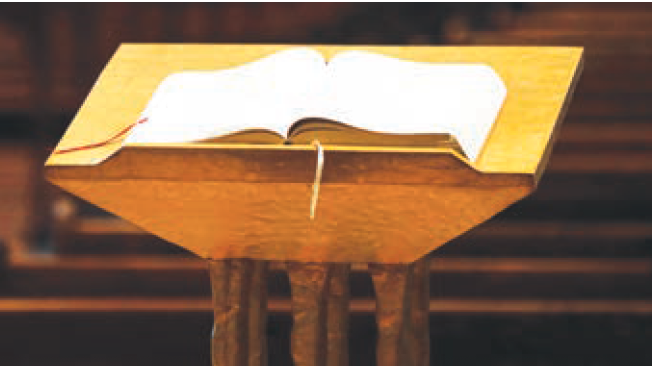
This language in the GIRM suggests that the ambo must be treated with a sense of exclusiveness, and not a place for extraneous, routine messaging or activities.
The Chair
In a parish church, the celebrant’s, or presidential, chair in the sanctuary should be clearly distinguished, but not designed or regarded as a throne. It is placed in a way so as to be seen by all the congregation. The chair is used by the priest acting in persona Christi, in the person of Christ. The celebrant not only sits here but also presides over the Mass. The deacon sits nearby: “The seat for the deacon should be placed near that of the celebrant. Seats for other ministers are to be arranged so that they are clearly distinguishable from those for the clergy and so that the ministers are easily able to fulfill the function entrusted to them” (GIRM, No. 310).
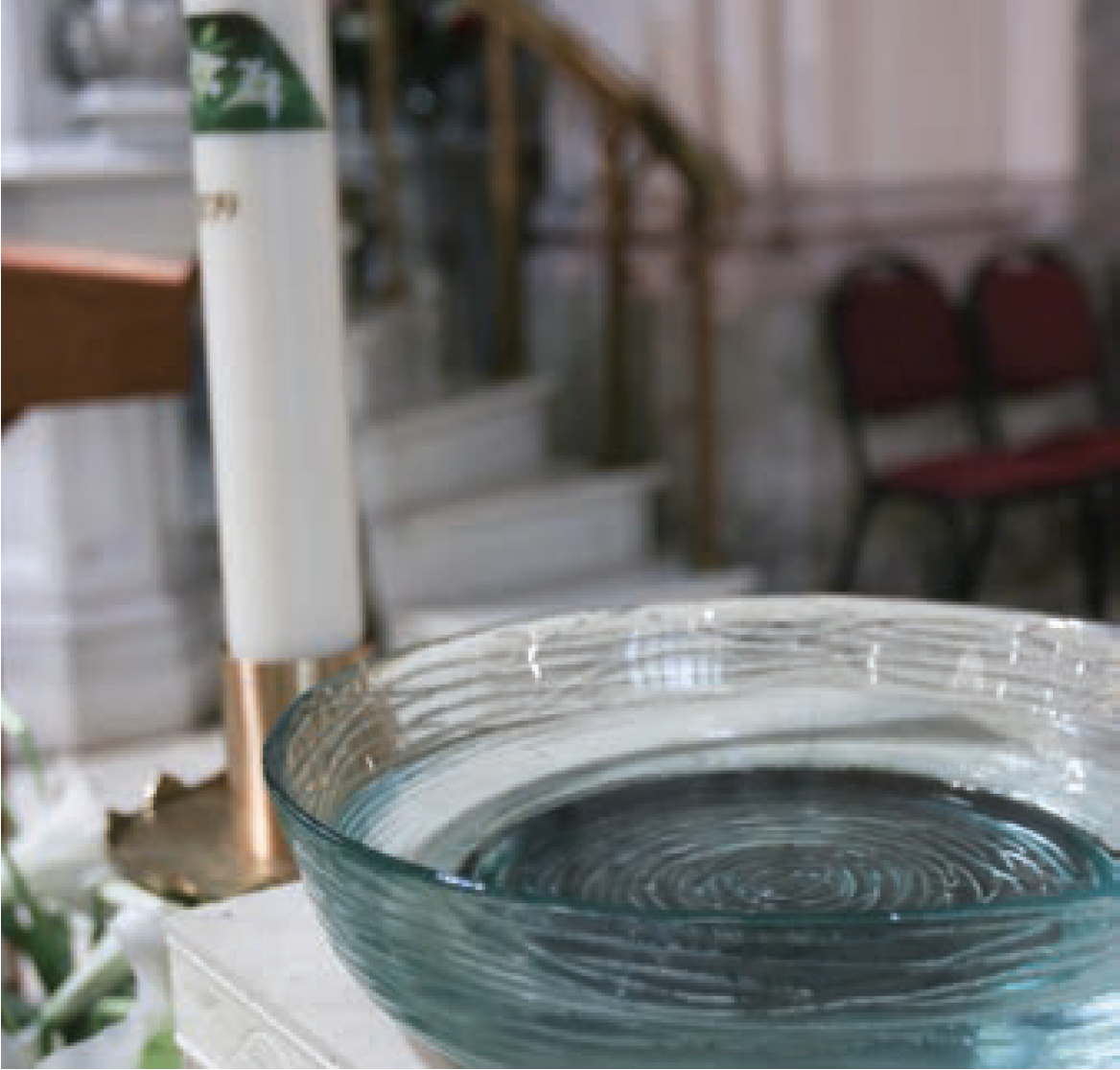
In many churches, the baptismal font is located in the sanctuary and the paschal candle is close by. Each parish shall have “one font that will accommodate the baptism of both infants and adults symboliz[ing] the one faith and one baptism that Christians share” (“Built on Living Stones,” No. 69). The font symbolizes the most important moment in the life of every Christian.
The paschal, or Easter, candle, new and blessed at the Easter Vigil, is lit for every baptism, as well as every funeral, and the glowing candle signifies a beginning (baptism) and an end (death). It sits close to the baptismal font except during the Easter season when it is moved next to the ambo and illuminates the holy word of God. It is also relocated and lit at funerals. The candle’s flame represents the light of Christ.
In sum, the chair, baptismal font and paschal candle further grace the sacredness of the sanctuary.
Other Decorations
Decorations, no matter the season, should not overwhelm the sanctuary. “Plans for seasonal decorations should include other areas besides the sanctuary. Decorations are intended to draw people to the true nature of the mystery being celebrated rather than being ends in themselves. … The altar should remain clear and free-standing, not walled off by massive flower displays or the Christmas crib, and the pathway in the narthex, nave and sanctuary should remain clear” (“Built on Living Stones,” No. 124).
“Built on Living Stones” also encourages the use of living plants and flowers, which “serves as a reminder of the gift of life God has given to the human community” (No. 129). The document does not say that artificial flowers cannot be used.
Well-meaning efforts to decorate can result in obstructing and distracting. Nothing should take our focus from the actions at the altar and the celebration of the Mass. The GIRM has this language regarding decorations: “Floral decorations should always be done with moderation and should be placed around the altar rather than on its mensa” (No. 305).
Given the dignity of the ambo, it is appropriate that the use of decorations should be similar to the guidance regarding the altar.
Decorations related to or associated with secular holidays are at best questionable. The sanctuary is not an area or for anything that profanes this holy environment. The USCCB discourages displaying the U.S. flag on the sanctuary and, if that’s the case, certainly other secular decorations are equally not appropriate. Instead, Church documents encourage fresh flowers in moderation.
Here are the USCCB words from their website regarding displaying the flag: “The bishops’ Committee on the Liturgy has in the past encouraged pastors not to place the flag within the sanctuary itself.” Rather, the bishops recommend it be located “outside the sanctuary, or in the vestibule of the Church.”
As we continue our focus on enhancing our love for the Eucharist, the place housing such a sublime gift, the Eucharist and presence of God, likewise deserves our respect. “Holiness befits your house, LORD, / for all the length of days” (Ps 93:5).
D.D. EMMONS writes from Pennsylvania.
……………………………………………………………………………………………………………………………………..
Location of the Tabernacle
According to numerous Church documents regarding the placement of the tabernacle, the desired and most appropriate place of the tabernacle is in the sanctuary or. as a minimum, in a chapel where it can be seen by the congregation:
“Consequently, it is preferable that the tabernacle be located, according to the judgment of the diocesan bishop: a. Either in the sanctuary, apart from altar of celebration, in a form and place more appropriate, not excluding on an old altar no longer used for celebration (cf. No. 303); b. Or even in some chapel suitable for the faithful’s private adoration and prayer and organically connected to the church and readily available to the Christian faithful” (General Instruction of the Roman Missal, No. 315).
Pope Benedict XVI writes in Sacramentum Caritatis: “Therefore, the place where the Eucharistic Species are reserved, marked by a sanctuary lamp, should be readily visible to everyone entering the church. … In new churches, it is good to position the Blessed Sacrament chapel close to the sanctuary; where this is not possible, it is preferable to locate the tabernacle in the sanctuary, in a sufficiently elevated place, at the center of the apse area, or in another place where it will be equally conspicuous” (No. 69).
Canon 938.2 reads: “The tabernacle in which the Most Holy Eucharist is reserved is to be situated in some part of the church or oratory which is distinguished, conspicuous, beautifully decorated, and suitable for prayer.”
— D.D. Emmons
………………………………………………………………………………………………………………………………………..

